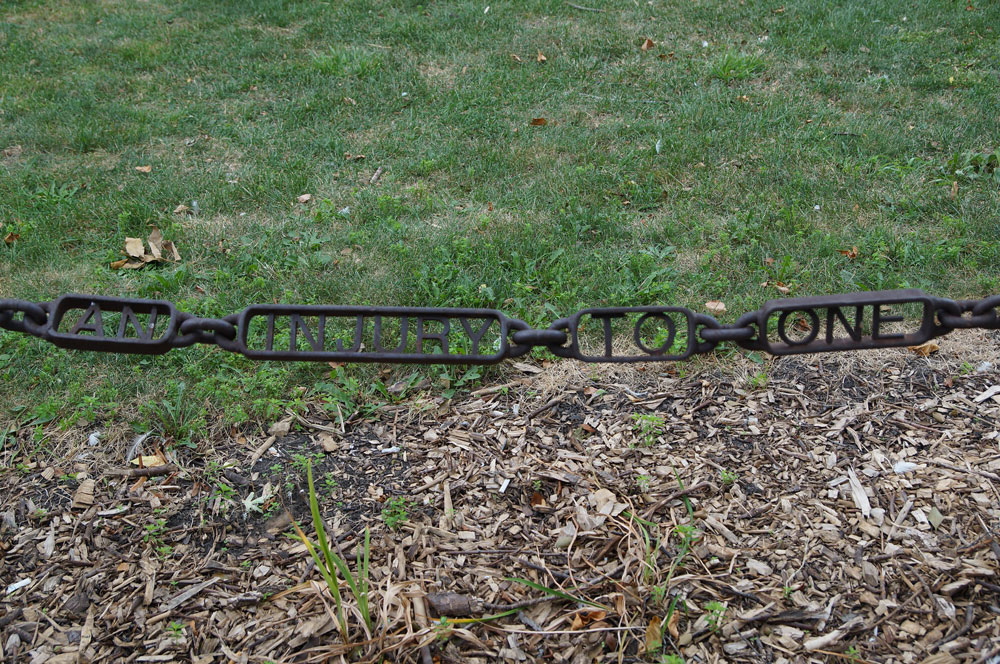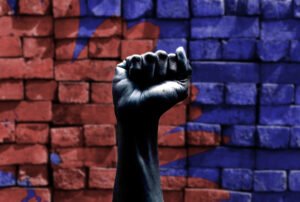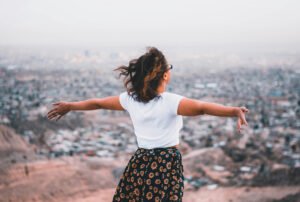
Today is Labor Day, and in a year in which the phrase “essential worker” has gained new meaning even as the routine lack of solidarity in the US has become more visible than ever, it seems appropriate to take stock of the state of the labor movement today.
The US does not do labor and unions well. Indeed, before proceeding, it is worth emphasizing that there is a big difference between “labor,” as in all working people, and “Labor” as in the union movement. According to the federal Bureau of Labor Statistics (BLS), in 2019, 14.6 million people, or 10.3 percent of workers, were in unions, and even that number is only as high as it is because of 7.1 million public sector union members.
There are actually fewer union members today in the US than in 1945. Back then, unions were 15 million strong, 35 percent of all US private sector workers. Today, in the private sector, only 6.2 percent of workers or 7.5 million people are in unions. By contrast, small-“l” labor—that is, the US labor force—exceeds 160 million people.
In the US, we also have a problem measuring the labor market. Right now, officially 13.6 million people out of roughly 160 million are unemployed. But that number dramatically understates the true level of pain. According to BLS, 29.2 million Americans are receiving unemployment insurance. How can 15.6 million more people be receiving unemployment insurance than are unemployed? Well, it’s possible because so many Americans in the “gig economy” are not counted in the unemployment figures even though they are not earning income.
Not only are our employment statistics and labor market understanding out of whack, but the US cannot even get the date of our Labor Day holiday right. Most countries hold Labor Day on May 1st to honor an 1886 march for the eight-hour workday in Chicago. You might notice that Chicago is an American city. But when Congress established Labor Day in 1894, it pointedly selected the first Monday in September instead.
In most of the world, May 1st was chosen as Labor Day to honor five people from that march who were unjustly executed for a bombing they did not commit (those involved became known as the Haymarket martyrs). As Voice of America puts it, “President Grover Cleveland did not want to choose the May date because of its association with the Haymaker bombing, so instead picked the alternative day in September.”
Why bother to recall this history? Well, because it speaks to a central trait that is in short supply in the US, but which is of vital importance in a pandemic—namely, solidarity. The rest of the world set Labor Day as May 1st in solidarity with those felled workers in Chicago, an honor we as a nation have failed to bestow ourselves.
Solidarity. It’s a trait that our hyper-individualistic US society notoriously stocks in short supply. Back in May, at NPQ we noted that “in the midst of the pandemic, the obvious lack of solidarity is plain for all to see.” The US lack of failure is caused by many things, including “our failure to dismantle white supremacy and an economic system marked by a uniquely virulent strain of dog-eat-dog capitalism.”
This is not just rhetoric. There have been, in fact, real life consequences. For example:
- The production of meat products has been prioritized over workers’ lives. A Centers for Disease Control and Prevention (CDC) study in July found that 86 meatpacking workers had already died of COVID-19 with total cases totaling 16,233, with 87 percent of those contracting the novel coronavirus being people of color.
- Healthcare workers, as has been widely covered, faced shortages of personal protective equipment, contributing to, according to Amnesty International, 1,077 health care worker COVID-19 deaths nationwide, the majority of whom are people of color.
- Day laborers and other undocumented workers have been denied federal unemployment and stimulus benefits, even as Americans rely on those workers to clean our subways and grow our food.
- Nursing homes have been a locus of COVID-19 deaths. The Centers for Medicare & Services (CMS) estimates 51,700 nursing homes deaths as of August 23rd. Workers, too, have been affected. A Connecticut story that came out in early July reported 3,400 cases of COVID-19 among nursing home workers and 14 deaths in that state alone.
- And it was only after massive tenant organizing and the growing prospect of tens of millions losing their homes in the middle of a pandemic that the CDC finally this week ordered a national moratorium on evictions. As Denise Scott wrote in NPQ last week, these tenants are also workers. As Scott observed, “In April 2020, the Fed estimated that 40 percent of those earning less than $40,000 were out of jobs—and they also happen to be the same people who need affordable housing.”
One could easily add to this list. The unwillingness of so many to wear masks—as if this were an individual choice, rather than a matter of social solidarity—comes to mind. So does the US Senate’s decision this summer to allow federal $600 weekly supplemental unemployment insurance payments to expire under the theory that workers are grifters living large on unemployment insurance.
And the death toll from the novel coronavirus in the US, over 187,000 and rising, would be far, far less if the US were a society marked by an ethic of mutual care and solidarity.
What is Solidarity?
It is perhaps important to clarify what is meant by solidarity. Solidarity can be lazily defined. For instance, Merriam-Webster defines solidarity as “unity (as of a group or class) that produces or is based on community of interests, objectives, and standards.”
Of course, unity is an element of solidarity, but such a definition is content- and context-free. If unity is all that is required, then police unions in which fellow police officers refuse to call out racist brutality in their midst could be said to be acting in solidarity because they support each other. Similarly, if all that is required is supporting your own, a member in a gang who kills a member of another gang in retaliation for losing one of its own likewise could be said to be acting in solidarity. Under the Merriam-Webster definition of solidarity, mafia members who abide by the law of omertà, allowing killings to continue, are also engaging in solidarity. But such lazy use of the phrase contradicts the meaning of the term.
True solidarity is not just about camaraderie within the group. It requires, to put it simply, learning from each other’s struggles, recognizing yourself and your common humanity in the other, and then acting to support others’ struggles. Put another way, if you are not building bridges across group lines, you are not acting in solidarity.
The formal labor union movement in the US mouths the words of solidarity, but too often it dumbs down solidarity to simply mean supporting fellow workers without a broader vision. This is how and why you can get police unions in which union members protect each other but lose sight of their mission “to protect and serve” the community. And in case anyone thinks this confusion of group cohesion and solidarity is a new problem, I will point out the Marlon Brando starred in On the Waterfront in 1954.
At the same time though, even in the US, you can find islands of solidarity, if you look for them. Sometimes these exist within social movements. For instance, the broad support of Black Lives Matter, whose protests have involved as many as 26 million people in what is perhaps the largest social movement in US history, clearly is a potent reminder of the US potential for solidarity.
Sign up for our free newsletters
Subscribe to NPQ's newsletters to have our top stories delivered directly to your inbox.
By signing up, you agree to our privacy policy and terms of use, and to receive messages from NPQ and our partners.
Labor Solidarity Today
The pandemic and the uprising against anti-Black racism have led to calls for labor unions to flex their oft-atrophied solidarity muscle as well. Back in March at the start of the pandemic, Jane Slaughter, former editor of Labor Notes, wrote:
If there were ever a time to say, “I’ll fight for someone I don’t know,” this is it. If we ever meant it when we said, “an injury to one is an injury to all,” now we’re seeing why that’s so.
Since Slaughter wrote those words, we have seen a rise in union activity. In the nonprofit sector, there has been an increase in union organizing, as NPQ’s Rob Meiksins covered in May. There have also been coordinated worker protests at large employers such as a set of actions on May 1st that called on Target, Amazon, Whole Foods, and Instacart to provide hazard pay and personal protective equipment. On June 9th, longshore workers engaged in a symbolic strike of 8 minutes 46 seconds to coincide with the funeral of George Floyd.
Yet one of the more important instances of labor solidarity occurred last month in the wake of the shooting in the back seven times of Jacob Blake in Kenosha, Wisconsin. And yes, that labor action began on a basketball court.
Milwaukee is just 40 miles north of Kenosha, so it makes sense that the players’ wildcat strike began with Milwaukee Bucks players refusing to take the court for a playoff game. What is remarkable was the strike’s spread. Not only did the basketball league shut down for three days, but athletes in baseball, football, soccer, and even hockey joined in.
Solidarity in the athletic world is somewhat paradoxical. After all, athletics is marked by a star system. According to an article in Forbes, as of 2016, the average football salary was $2.1 million and the average basketball salary $6.2 million. Baseball falls in the middle at $4.4 million.
Sports also celebrate the individual. The late Muhammad Ali said, “I am the greatest!”—not “I am part of the beloved community.” Yet Ali also refused to register for the draft because he opposed a war in which there are “white people sending black people to fight yellow people to protect the country they stole from the red people.”
The fact that many athletes grow up in poverty and so many are people of color—a few years ago it was estimated that 74.4 percent of players in the National Basketball Association (NBA) and 69.7 percent in the National Football League (NFL) were Black—places many athletes in a liminal space, having achieved “elite” status and yet often having grown up in decidedly non-elite circumstances. The combination can create both the motivation to act and the ability to do so.
Sports protest in the US is hardly new. As we noted in NPQ three years ago, historically, it has been “on the field of play where many decisions about American identity and yes, politics, are made.”
Back in the fall of 2017, entire NFL teams took a knee during the playing of the national anthem in solidarity to protest police violence and disparaging remarks made by Donald Trump. At the time, sports critic David Zirin observed that “nothing, literally nothing, in the history of sports and politics can compare to what happened on [that] Sunday.”
And yet, the significance of that Sunday pales when set against the events of the past month. There have been many strikes over contracts in sports, but never solidarity wildcat strikes motivated by racial justice concerns involving multiple professional leagues. (Baseball players had a two-day walkout in response to the assassination of Dr. Martin Luther King, Jr.)
The language used can be confusing. Because wildcat strikes are illegal, many players intentionally mislabeled the strikes as boycotts to get around that prohibition. But there is no doubt that athletes were refusing to labor (play games), not refusing to buy tickets (which is what a boycott would be).
After three days, the strikes ended with league owners making commitments to work with players to address racial justice issues more directly. For instance, the NBA agreed to use several basketball arenas as voting locations and to form with players a league-wide social justice coalition.
Will the solidarity strikes have a broader, lasting impact on the labor movement and the willingness of other unions—service workers, teachers, auto workers, teamsters, and so on—to take similar actions? That remains to be seen.
For his part, Zirin believes such an outcome is possible. Writing in The Nation, Zirin calls on the labor movement “to act with similar urgency at this political moment, and not expect athletes to do it for us.” Zirin adds, “Striking for Black lives is now on the table, not as an abstraction but as a goal worth fighting for.”













